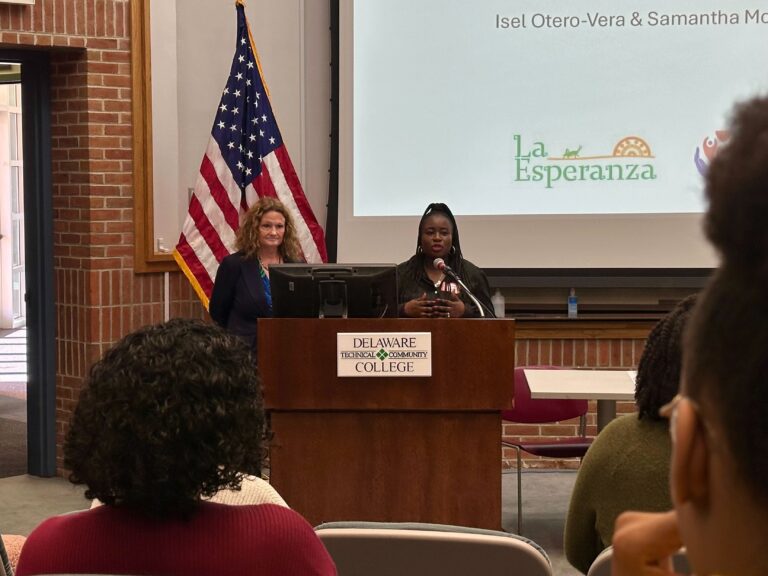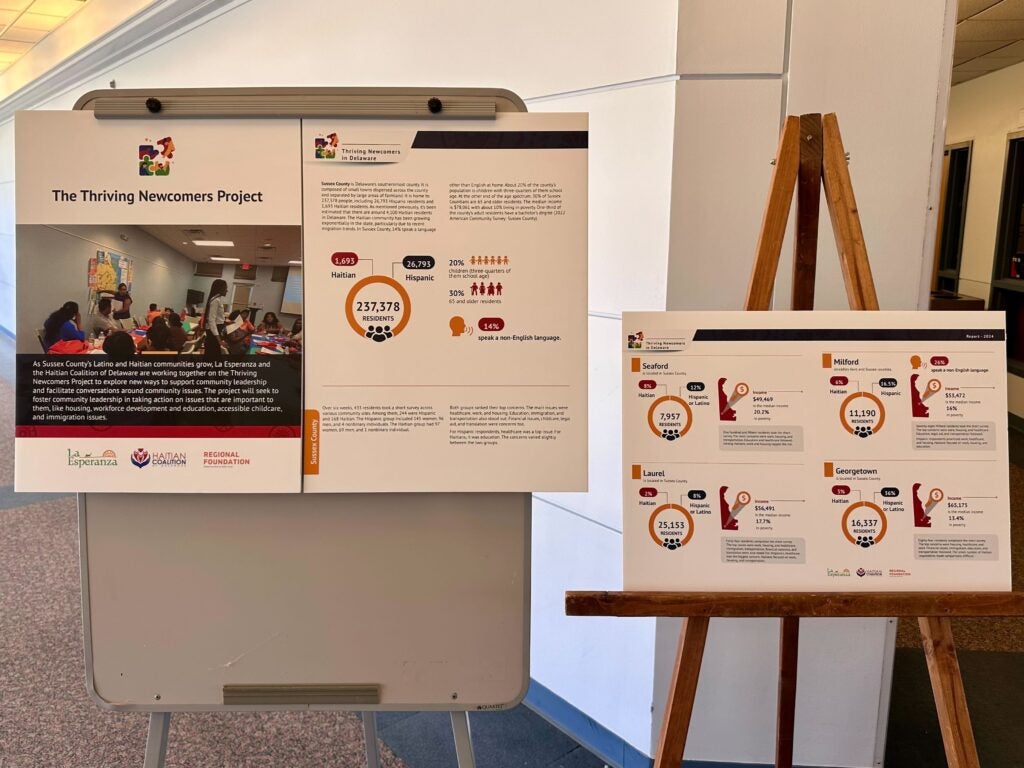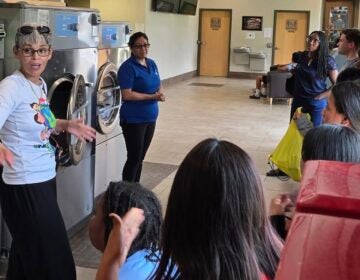Haitian and Latino immigrants in rural Delaware confront housing, employment and child care challenges
A new report shows how Haitian and Latino immigrants in southern Delaware are often caught in an economic divide.
Listen 1:40
Jennifer, on the left, and Midline, on the right, from La Esperanza presents findings from the Thriving Newcomers Project at Delaware Technical Community College. Their work focuses on addressing the unique challenges faced by Latino and Haitian communities in Sussex County. (Johnny Perez-González/WHYY)
From Philly and the Pa. suburbs to South Jersey and Delaware, what would you like WHYY News to cover? Let us know!
Each morning in Sussex County, as the sun rises over Delaware’s rural farmland, thousands of workers — many of them Haitian and Latino immigrants — prepare for long shifts in poultry plants, restaurants and agricultural fields. They are essential to the region’s economy, yet they face challenges that extend far beyond the workplace. From housing shortages to transportation difficulties, navigating daily life in a new country remains an uphill battle.
This past weekend, La Esperanza and the Haitian Coalition of Delaware released the “Thriving Newcomers Report,” a comprehensive study examining the state of immigrants and newcomer communities in Sussex County. After a yearlong effort that included 433 surveys, the findings were clear: housing, education, employment, childcare and immigration emerged as the five greatest concerns.
Sussex County, home to about 237,000 residents, has seen significant demographic shifts in recent years. Nearly 27,000 residents identify as Hispanic or Latino, and the Haitian population is estimated to be around 1,700. As these communities continue to grow, so do the barriers they face in accessing essential services and opportunities.
A county divided: The coastal economy vs rural challenges
One of the key factors shaping these challenges is the geographic divide between eastern and western Sussex County. The eastern side, which includes resort towns like Rehoboth Beach and Bethany Beach, offers more job opportunities due to its tourism-driven economy. However, the cost of living there is significantly higher.
“It’s not surprising … there is a difference between the east and the west,” said Jennifer Fuqua, executive director at La Esperanza. “Because the east coast is a resort area, it tends to have a much higher median income as well as the housing costs being much higher. And so, people tend to live in the western part so that they can afford to live and make sure that the cost of living is meeting what their income is.”
Many immigrants and lower-income residents work in hotels, restaurants and seasonal businesses along the coast but live in western Sussex County — in towns like Georgetown, Seaford and Milford — where housing is more affordable.
However, even in these areas, residents face significant obstacles.
Persistent barriers
Despite lower housing costs in western Sussex, availability and quality remain serious concerns. Many immigrants live in overcrowded conditions or in homes that lack proper infrastructure. Fuqua emphasized that securing stable housing is a top priority for families.
“Overwhelmingly, the No. 1 issue of concern for people is having options for housing because people have families and need different options for housing,” she said. “They represent, like I just said, a significant amount of the workforce in Sussex County, but they find it difficult to find appropriate housing options for them.”
Transportation is another major hurdle.
“Most people have to find a way to get to work,” Fuqua said. “Local employers want them to work, but transportation is a big issue. And so people are very resilient and creative and they find ways to get to work, but it’s also a big barrier. And having housing close to where they work is one of the big prime concerns that people have.”

Unlike New Castle County, which has a more developed public transit system, Sussex County is largely rural, with limited bus routes. Many workers rely on carpooling or informal ride-sharing networks, which can be unreliable and costly.
For immigrant parents living in western Sussex County, finding childcare is particularly difficult.
“Having culturally relevant and accessible child care so that people can work is another big concern that people have,” she said. “It’s very often the case that people do shift work overnight, so it’s just not an option to use a traditional child care center.”
In rural areas, child care centers are scarce. While eastern Sussex has more resources due to its higher-income population, the western side lacks enough licensed childcare facilities to meet the needs of its growing population.
Haitian and Latino communities: different cultures, share struggles
Although Haitian and Latino immigrants come from different cultural backgrounds, their experiences in Delaware are deeply connected. Keda Dorisca, co-founder of the Haitian Coalition of Delaware, highlighted how bringing these communities together revealed their common struggles.
“I think through bringing all of these different advisory committee groups together, they were able to find the through line between both of their experiences and connect on the issues that they are both facing,” she said. “Even though culture is different, and that was the beauty of this cohort… they were able to exchange their culture with one another and it showed the beauty of really being a community with one another.”
“We actually want and need the same things. We actually are experiencing the same things,” she added. “Everybody wants their kids to have the same opportunities. Everybody wants to live in quality housing. Everybody wants to have good early child care and education for their child. Everybody wants good transportation.”
Haitian Coalition co-founder Midline Oware echoed this sentiment.
“The sense of camaraderie, I think that was formed, bringing these different cultures together, and for us to really get a chance to kind of share our cultural experiences and really realize that … we all face a lot of the same challenges,” Oware said.
With the findings of the “Thriving Newcomers Report” now public, local leaders are focused on finding solutions to the challenges it has identified. Next month, they plan to host a retreat where educators, workforce leaders, childcare providers and housing advocates will meet to discuss strategies for addressing these persistent issues.
Their stakeholder meeting will take place March 29 at the Sands Convention Center in Rehoboth Beach. Organizers hope this gathering will lead to concrete steps toward improving housing, education, employment, childcare and immigration support for Sussex County’s growing immigrant communities.

Get daily updates from WHYY News!
WHYY is your source for fact-based, in-depth journalism and information. As a nonprofit organization, we rely on financial support from readers like you. Please give today.







